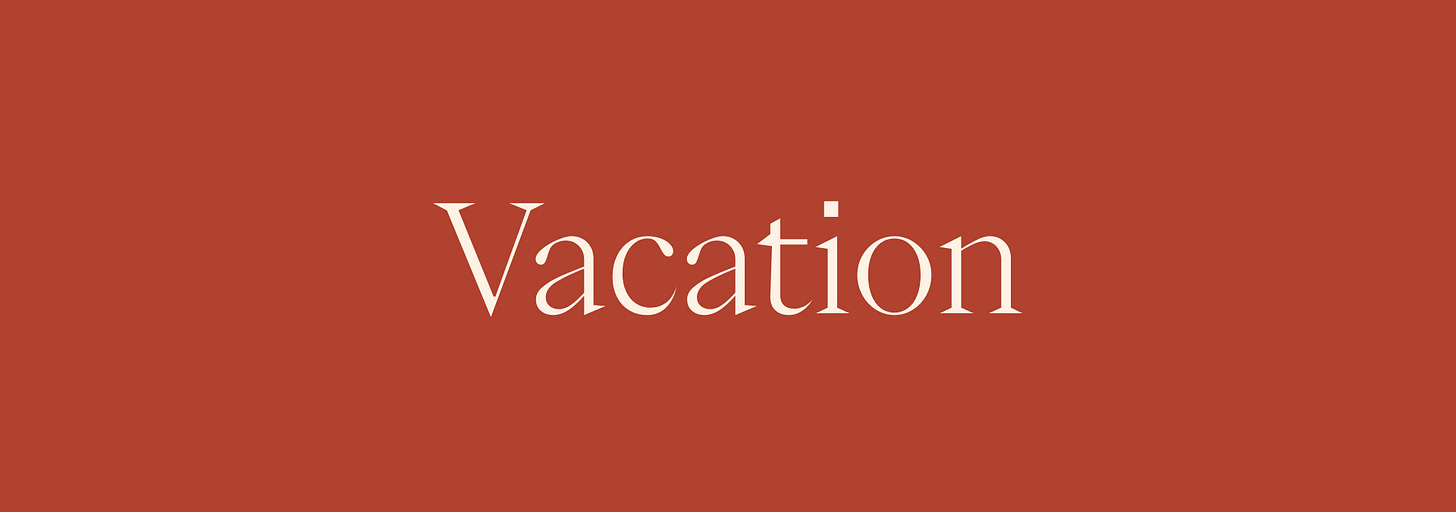Hi! Happy Monday ◡̈
Today’s letter is coming to you on a Monday as opposed to a Sunday as usual because the weekend quite literally escaped me—a blur of moments that, try as I might, I cannot piece together. It's a bit unsettling how quickly time slips through our fingers, especially as we grow older.
But, today (sorry again!), I want to chat about these three brands whose aesthetics I love, but whose strategy and positioning I love even more. They do certain things intentionally, and I’ll talk about what these are.
Every week I go behind my favourite brands, unpicking things I love or maybe don’t love so much, all in an effort to give you the necessary insights to help build your brand. So many brands exist for you to follow by example. So maybe you should x
I love Aesop. The packaging, the smell of their hand soaps, the ingredients. It’s one of my favourite luxury brands. But it is expensive. £33 for a hand cream??? Believe it or not, the price of Aesop’s products isn’t the only reason I know that this brand is a luxury one.
I know Aesop is a luxury brand because:
I don’t find it when I’m shopping at my local Boots or Superdrug. But I do find it in Harrods, Harvey Nicols, or Selfridges.
They have no stores in places like Peckham, Hackney, Deptford, or Dagenham. But there are plenty dotted throughout central London in places like Reagent Street, Marylebone, Hampstead and Mayfair (conceivably equivalent to the Upper East Side).
I find them in the bathrooms of super-chic and luxury hotels and restaurants. This tells me everything I need to know.
That is to say that everything I know about Aesop’s products is based on where they are sold and found. And where a product is sold and found says a lot about the product. Even more so for brands that want to be perceived as luxury.
Besides the price of a product, if there is no association with a certain standard of living, level of quality, symbol, or status, then there’s nothing that makes us believe that a product is a luxury. Much of Aesop’s success can be attributed to the physical places where they are found. And sometimes distribution says all we need to know about a product. Their products are found in places that align with their brand ethos—be it sophisticated hotels, chic restaurants, or curated boutiques. This goes beyond aesthetics; it's a calculated move to place their products where they naturally belong, creating an instant connection with their target audience.
Brand tip: More brands need to start looking at distribution as a method of brand-building.
I first discovered Vacation through Kim Kardashian's Instagram story, where I think she raved about their whipped sunscreen or something. Instantly intrigued, especially because I’m all about immersive and experiential branding (I talk about that here and here), Vacation stood out with its fun, nostalgic vibe. They do some very impressive world-building.
If you haven’t heard of or seen the brand before, the best way I can describe it is: sun care, 80s beach culture, bold colours, palm trees, and nostalgic vacations. Co-founder Marty Bell describes the brand as a mix of "The Office" TV show and Jimmy Buffett's brand world, which basically = humour and "island escapism."
It’s fun, it’s wacky, and it almost feels like they prioritise having fun over actually selling their products, but it works because, in a world where we're constantly being sold to, Vacation offers a satisfying escape. And they do this really well—I find myself scrolling through their Instagram page longing for the "good old times" I never had (being a Gen-Zer who was literally born 20 years after the 80s).
“If we’re going to be putting our brand in front of people every day on Instagram, we have to entertain them. We can’t just post bottles of sunscreen every day. It’s unfair to just throw it in your followers’ faces every day, saying, ‘Here’s another photo of my product on a beach. Here’s another photo. Are you going to buy it today? Here’s another photo. Do you want to buy it today?'”
Brand tip: build a world that your brand can exist in and create entertainment for your audience.
You've probably caught a glimpse of at least one Billie razor campaign by now. They're known for being entertaining, and incredibly relatable, yet they don't shy away from discussing more profound issues. Billie was the first women's razor brand to acknowledge that body hair exists with its viral campaign, Project Body Hair, which has over 22m views and has ignited an industry-wide trend.
Launched in 2017 by Georgina Gooley and Jason Bravman, Billie hit the ground running by tackling the "pink tax"—the higher prices women often pay for razors compared to men. This move, along with their subscription service, quickly set them apart in the crowded market. What I love about Billie is how they manage to balance being lighthearted and humorous while also diving into deeper social issues. Their Instagram has the vibe of a meme account, making their mission even more accessible.
As Billie ventures into body care, they're continuously finding clever ways to challenge beauty norms, like their twist on the classic "10 Things I Hate About You" for a recent ad featuring Jameela Jamil. And though this campaign received both hate and love, I do think it’s a creative attempt that’ll get people to watch no matter what their stance. A piece of branding advice I always stand by is to avoid indifference. Either make someone hate your brand or love it but being able to evoke some sort of emotion means you’re doing something right.
“Even though we were founded in 2017, this is only our second year of national omnichannel availability, and when you walk down the shave aisle, you’ll notice it’s filled with decades-old brands,” the company said in an email. “As a brand that’s newer to retail, it is important to keep investing in brand building.”
Brand tip: Have a story that resonates with your audience (55% of consumers are more likely to buy a product if they love a brand’s story).
Weekly musings:
E.l.f. Beauty opens London office: The move signifies the brand's expansion and strategic move to establish a stronger presence in the UK market. This could enhance their European operational capabilities and signify their commitment to global growth.
Whatever Happened to the “Fenty Beauty” Effect? The beauty industry's response to the call for diversity, notably after Fenty Beauty's launch, has been mixed. While some brands have expanded their shade ranges, the effort often lacks depth, failing to match the diverse undertones of darker skin. The issue extends beyond foundations to other products like concealers and bronzers. Honestly, I don’t know why it’s surprising that we don’t just want a brand to act like they’re inclusive, but to actually be inclusive. Certain brands just don’t care to put in the time or effort to acknowledge every skin tone. Apparently, it’s expensive to get it right, but then there are brands like Tarte in Bora Bora. That’s right, Tarte is flying out influencers again (after all that drama last year). Before the trip had even started, influencers were gifted with Jordans, a CANON G7X camera, Beis bags, and more. They were flown out on private jets, and it all seems a little out of touch. Or am I just jealous? There are a lot of strong opinions on TikTok; just search “tarte bora bora” and go through the comments. But it goes back to what I said about avoiding indifference. Tarte still made its way into your discussion, whichever side you're on, and these brand trips are just indirect marketing.
What 8 DTC brands are talking about in 2024: direct-to-consumer (DTC) brands, which initially focused on selling directly to customers online to keep prices low, are now partnering with retailers to reach more customers. This shift is a result of the evolving market and the need for growth. Key takeaways include:
APL highlighted the benefits of wholesale as a form of marketing and shared their success in various high-end retailers.
Crocs emphasised the importance of balancing direct sales with wholesale to effectively reach a broad audience.
Glossier aimed to build a long-lasting brand by connecting with consumers on an emotional level across various channels.
Lovesac focused on creating durable, customizable furniture, seeing strong returns on advertising spend.
These insights reflect a broader trend where DTC brands are adapting to market demands and exploring new strategies for expansion and customer engagement.
Huda Kattan Is Back as CEO of Huda Beauty, and She’s Redesigning Her Brand: Huda Kattan has announced a major rebrand for Huda Beauty, including a new logo, brand identity, and packaging. This change, set for completion by the end of the year, comes as Kattan retakes her position as CEO, aiming to bring back her vision to the brand's core. The rebranding will also see the discontinuation of certain products, including the Glowish line, as part of streamlining the product portfolio. I’m excited to see how this will look…
Will Gen-Z Buy Anything Millie Bobby Brown Sells? Despite a robust social media following and the expansion into diverse product lines, there's a discernible gap between fan admiration for Brown and actual product purchases. This scenario raises questions about the brand's actual market impact versus its perceived popularity, largely fueled by Brown's celebrity status. While celebrity-founded brands can leverage fame for initial traction, long-term success hinges on product quality and brand authenticity that resonates with consumer needs and preferences. Maybe Florence should take a page out of Skims’ playbook.
The rise of chrome across all industries: The anticipation of the 2024 Paris Olympics is influencing fashion trends, with Vogue predicting a rise in metallics, particularly gold, silver, and bronze, reflecting the event's medals. Pinterest's trend report, "Hot Metals," highlights a shift towards metallics, driven by Gen Z and Millennials, affecting fashion and interior design. This crossover trend is also seen in packaging design, as observed at Luxe Pack LA and in new products on Sephora, showcasing chrome's increasing popularity across beauty, beverages, and beyond. Chrome's polished and authoritative aesthetic is expected to become more prominent in packaging design, indicating a broader application in the near future. I called it! Just saying…
Thanks for reading! Find more here. If you like, you can share here.










